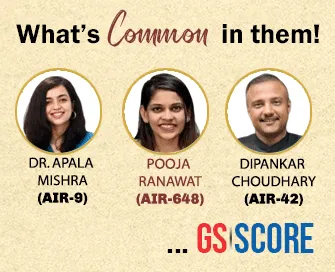

18th September 2023 (9 Topics)
Editorials
Context:
The Shanti Swarup Bhatnagar Prize, an esteemed scientific award in India, has consistently overlooked women scientists, with only 19 out of nearly 600 recipients being women, despite women constituting 14% of the country's working scientists.
Gender Disparity in Scientific Awards
- Persistent Gender Gap: The Shanti Swarup Bhatnagar Prize, a prestigious scientific award in India, has faced consistent criticism for its failure to recognize women scientists. Out of nearly 600 awardees, only 19 have been women, highlighting a significant gender disparity in this recognition.
- Impact of the Bhatnagar Prize: Beyond individual recognition, the Bhatnagar Prize also elevates the profile of the recipient's institution. This ongoing gender disparity not only affects women scientists' careers but also reflects on the scientific community's inclusivity and fairness.
- Inadequate Justification: While women constitute about 14% of India's working scientists, the argument that "there aren't enough women" to justify this persistent gap is undermined by the continued underrepresentation of women in scientific awards.
Opaque Selection Process and Lack of Transparency
- Non-transparent Selection Process: The main issue contributing to gender disparities in the Bhatnagar Prize is the lack of transparency in the selection process. Nominees are chosen by senior figures in the scientific community, primarily men, leading to biases and discrimination.
- Need for Representation: The absence of gender diversity in the bodies responsible for nominations perpetuates gender biases and discrimination, making it crucial to increase the representation of women in nominating bodies and decision-making processes.
- Calls for Accountability: To address these disparities effectively, there is an urgent need for transparent nomination processes, the inclusion of more women in key nominating roles, and public statements of intent from institutions to promote gender equity, fostering inclusivity and fairness in the Indian scientific community.
Challenges and the Path Forward
- Diverse Challenges: Women in science continue to face challenges like ageism, casteism, sexism, and the dominance of old boys' clubs, hindering their careers and limiting inclusivity in the Indian scientific community.
- Recent Initiatives: Some steps have been taken to address gender disparities, including the appointment of N. Kalaiselvi as the first woman chief of the Council of Scientific and Industrial Research (CSIR) and a gender parity survey conducted by CSIR.
- Urgent Need for Accountability: Despite these initiatives, the ongoing gender gap in prestigious scientific awards calls for greater accountability and proactive measures to ensure equal recognition and opportunities for women scientists in India.


Editorials
Context:
In recent years, India has excelled globally in climate change, electrification, manufacturing, and space exploration, yet it grapples with a growing health crisis from non-communicable diseases, endangering its demographic dividend and development prospects.
Emerging Global Role and Concurrent Health Crisis:
- India's Global Leadership: India is emerging as a global leader in areas like climate change, electrification, manufacturing, and space exploration.
- Health Crisis: Simultaneously, India faces a growing health crisis with rising cases of diabetes, hypertension, heart diseases, cancer, respiratory issues, and depression.
- NCDs' Economic Impact: If unaddressed, India's non-communicable diseases (NCDs) could cost nearly $4 trillion by 2030, posing a significant obstacle to the country's development and demographic dividend.
Healthcare Industry's Role in Combating NCDs:
- Awareness and Lifestyle Advocacy: The healthcare industry should raise awareness, advocate healthier lifestyles, and offer comprehensive health check-ups with advanced scans for early disease detection.
- Healthcare Progress: India has made remarkable progress in healthcare, including improvements in infant and maternal mortality rates and increased life expectancy.
- MVT Hub: India boasts world-class healthcare infrastructure and clinical talent, making it a fast-growing destination for medical value travel (MVT) due to quality and cost-effectiveness.
Potential of Artificial Intelligence (AI) in Healthcare:
- AI-Driven Solutions: India's healthcare sector is actively adopting AI-driven solutions, especially in diagnostics, to enhance accuracy and efficiency.
- AI's Transformative Role: AI can predict disease outbreaks, analyze healthcare data, revolutionize drug discovery, and significantly improve patient outcomes.
- India's AI Potential: With a substantial pool of data scientists, engineers, and healthcare professionals, India is positioned to lead in AI-driven healthcare solutions, potentially adding $1 trillion to its economy by 2035.


Editorials
Context
The recurring disruptions in India's Parliament, characterized by members' preference for disruption over debate, have eroded the effectiveness and credibility of the legislative body, raising concerns about the state of India's democracy.
Parliamentary Disruptions in India: A Growing Concern
- Deteriorating Parliamentary Conduct: Recent years have seen a disturbing trend of frequent disruptions in India's Parliament. Rather than engaging in substantive debates, many parliamentarians resort to disruption tactics, undermining the core purpose of the legislative body.
- Historical Embrace of Westminster Model: Post-independence, India embraced the Westminster-style parliamentary system, with its traditions inspired by the British model. Indian MPs initially adhered to decorum, including desk-thumping and the use of "aye" during votes, signifying their commitment to democratic principles.
- Erosion of Parliamentary Decorum: However, over seven decades of independence, Indian Parliament has witnessed a decline in parliamentary decorum. Unruly behavior, shouting slogans, and flouting codes of conduct have become commonplace, resulting in sessions marred by disruptions and chaos.
British Parliamentary Practices for Reform:
- Opposition Day: India can learn from the British practice of allocating an "Opposition Day" each week. This would provide the opposition with a dedicated platform to set the parliamentary agenda, fostering meaningful debates and reducing the incentive for disruptions.
- Prime Minister's Question Time (PMQs): Emulating the UK's PMQs in India could enhance accountability. This practice allows MPs to question the Prime Minister on various issues, promoting transparency and rigorous scrutiny of the executive.
- Reforming the Role of the Speaker: To instill discipline and decorum, the Speaker should play a proactive role. Accepting adjournment motions, ensuring separate votes on amendments, and acknowledging dissent through "division" are vital parliamentary techniques to maintain the value of dissent.
Conclusion: The Way Forward for India's Democracy
- Building Consensus: It is crucial for the government and the opposition to collaborate on implementing these reforms to restore the credibility and effectiveness of India's Parliament.
- Strengthening Democracy: By adopting these British parliamentary practices, India can ensure that its democratic institutions remain robust, transparent, and accountable.
- Preserving Parliamentary Democracy: The timely adoption of these reforms can prevent further erosion of India's parliamentary democracy, promoting a culture of reasoned debate over disruptions.


Editorials
Context
A proposed legislative move (Chief Election Commissioner and Other Election Commissioners (Appointment, Conditions of Service, and Term of Office) Bill, 2023) to downgrade the status of members of the Election Commission (EC) in India is causing apprehension.
Undermining the Role of Election Commission:
- Legal Equivalence at Stake: The current status of the Election Commission places its members on par with Supreme Court judges, underscoring their critical role in upholding democratic processes.
- Proposed Downgrade: The Chief Election Commissioner and Other Election Commissioners (Appointment, Conditions of Service, and Term of Office) Bill, 2023, proposes aligning EC members' service conditions and salaries with that of civil servants.
- Diminished Authority: While financial remuneration may not be the core issue, the bill's potential to downgrade EC members to the status of civil servants sends a disconcerting signal. It could limit the EC's authority to discipline political leaders during crucial election periods.
The Importance of an Independent Election Commission:
- Constitutional Empowerment: Article 324 of the Indian Constitution grants the EC independence and tasks it with the crucial responsibility of "superintendence, control, and direction of elections."
- Guardians of Democracy: Over the years, the EC has grown into an impartial and fair institution, enhancing the legitimacy of India's electoral system.
- Historical Significance: The EC's standing was significantly fortified in the 1990s when former CEC T. N. Seshan firmly asserted its constitutional role in enforcing electoral rules.
Challenges and the Need for Reflection:
- Erosion of EC's Impartiality: While the EC has enjoyed a reputation for impartiality, recent instances have raised questions about its adherence to these standards.
- Bill's Shortcomings: The proposed Bill fails to recognize the EC's exceptional standing and importance in safeguarding democracy. Arguments related to the "table of precedence" miss the point, as this issue transcends mere protocol and concerns the autonomy and dignity of the EC.
- Call for Reconsideration: To protect the institution's dignity and autonomy, the government should reconsider the proposed legislation and acknowledge the EC's vital role in India's democracy.




